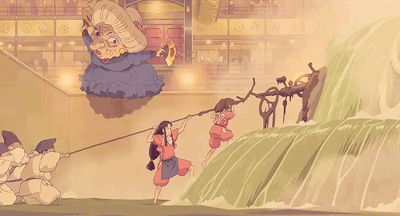TRIVIAL
Understanding the Symbolism for Environmentalism Behind Studio Ghibli Movies
by Didem ÖZÇAKIR
Studio Ghibli movies introduce us to a whole new world that we have never even thought could exist. This whole new world is colorful and vivid and it has protagonists and characters who are very far from what we are used to. While we are generally accustomed to seeing wizards, spaceships or superheroes in movies, Ghibli movies can use a pig who is a war pilot as their main hero. The movies can be appreciated for their imaginative world and their storytelling skills, but this is not the only thing that we get from them. Miyazaki and the other directors use the power of symbolism and metaphors in their movies so that they give meaningful, universal messages which are worth thinking about. Studio Ghibli movies also show their success by holding spots in the IMDB top 250 and being the only Japanese animations to win an Oscar.
When we think about Studio Ghibli as a whole, two main themes catch our attention: environmentalism and an anti-war effort. This does not necessarily mean that every Studio Ghibli movie tries to convey a political, universal message through symbolism. Think about My Neighbor Totoro and you will see that although the movie has messages about the power of sisterhood, its main message is not necessarily political. The Cat Returns can be another example of Ghibli movies which take all of their power from the vivid world that they create. Before we move on, I want to note that there are some spoilers throughout the rest of the article.
Thinking about environmentalism, perhaps the most obvious theme in the movies, three movies specifically come to my mind: Spirited Away, Princess Mononoke and Nausicaa of the Valley of the Wind. Princess Mononoke’s emphasis on environmentalism is obvious and it does not especially rely on symbolism. We watch the adventures of San and Ashitaka who try to calm the spirit of the forest. Thinking the extent of the powers of the spirit of the forest and how it reacts to humans consuming the resources, the message becomes clear: Miyazaki wants to tell us how the nature is the most powerful entity on earth, and how it will heal itself despite mankind’s pressure on resources, causing a destruction for humans along the way.
Nausicaa of the Valley of the Wind is the first work of the studio, which was published in 1984, actually before Studio Ghibli became an official animation studio as we know it today. We can also understand how environmentalism is important for Ghibli from here: Their first ever movie that they published is about it. In this movie we see a futuristic world in which only a few humans can live as a massive pollution layer covers up most of the world. People live in rural villages and kingdoms. Nausicaa is the princess of the little settlement in the Valley of the Wind and throughout the movie she tries to save her village from the attack of another powerful kingdom. We again see an emphasis on nature’s healing capacity in the scene where Nausicaa falls below the layer of dirt and sees how the world is healing below that. The end of the movie when massive mutant insect Ohms come to destroy the war area, who are used to symbolize the power of nature, again conveys a familiar message. We see how nature is the most powerful thing that can make all our worldly concerns unimportant.
Spirited Away is perhaps one of the best movies that was ever made. It creates a whole new world, that focuses on a bathhouse for spirits with a train going on water. Every time you watch the movie it is possible to get a different message by focusing on another detail. We can see the growing up journey of Chihiro, power of love (when Chihiro gets the train ticket that was hid for forty years to save Haku, and when No-Face becomes a peaceful creature after going to Zeniba), the problematic nature of greed (when Chihiro’s parents become pigs, and when No-Face starts to eat the spirits who get gold from it). The power of identity and environmentalism were themes in the movie that did not get my attention in the first watch, but in the second. How the names of Haku and Chihiro change when they start to work in the bathhouse, and how they try to remember their names to not forget who they are in the real world conveys the importance of identity. Environmentalism shows itself most prevalently in the scene where a stinky spirit comes to the bathhouse and the job of washing it is left to Chihiro. Chihiro finds a ledge on the body of the spirit and when she pulls it a massive ball of dirt comes out of the spirit. This ball of dirt is composed of all our daily tools: bicycles, refrigerators etc. We see how the old river spirit is in pain because of all the things in it, which can also be found in a real river. Thinking about this together with the theme of greed, we can even say the whole movie is about environmentalism as the greed of mankind to have more and more is the main thing that destroys nature.

I hope the next time you watch a Studio Ghibli movie you also try to get the message that it gives!


